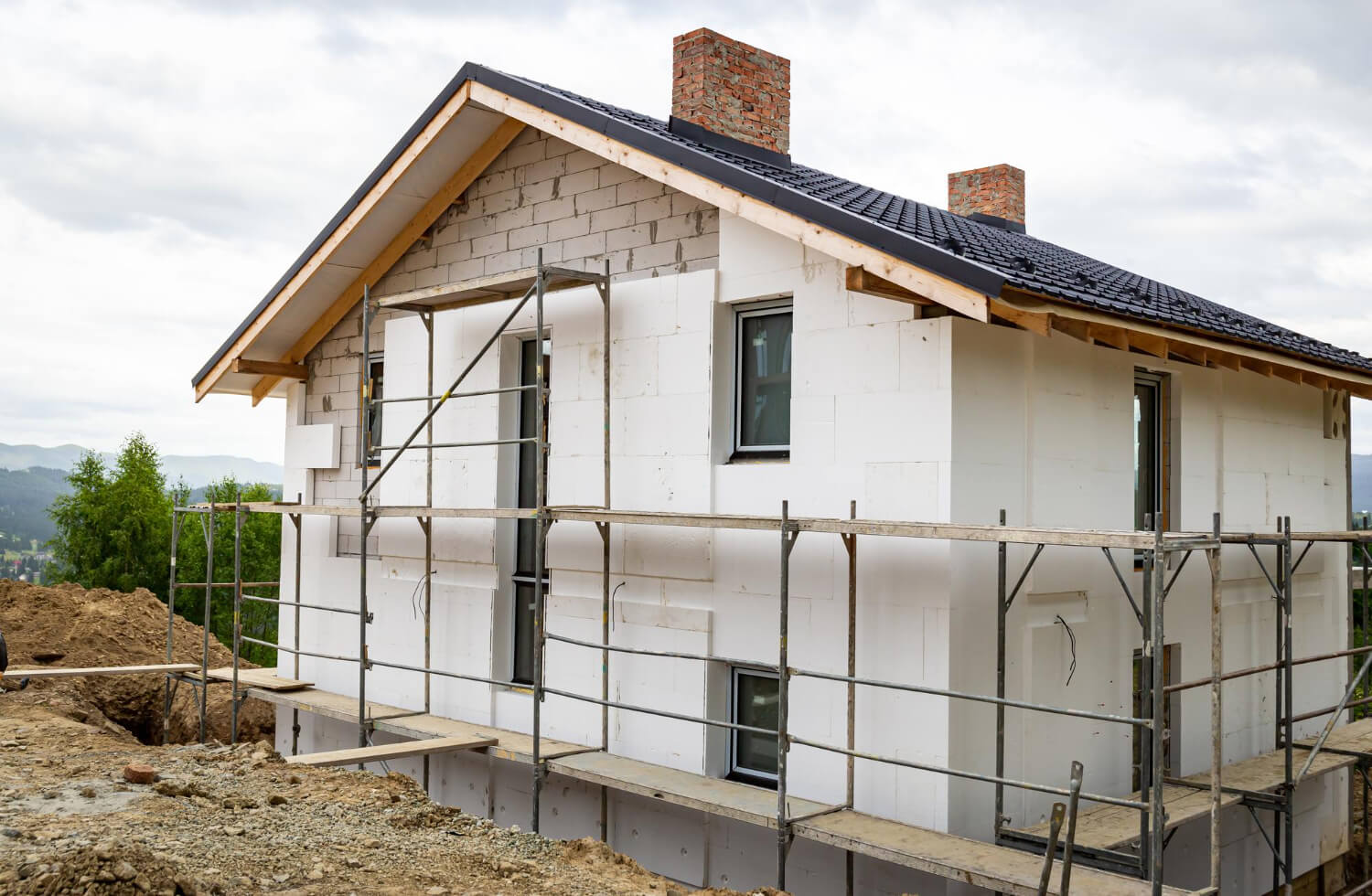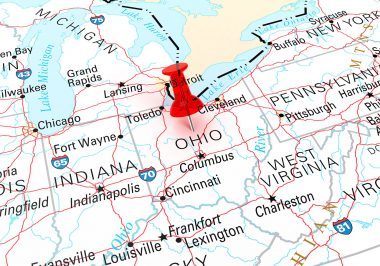Blog Guides Lending and mortgage
Can You Build a House with a VA Loan? Complete Construction Guide [2025]
Updated Fri, Nov 21, 2025 - 33 min read
Top blog articles
Building your dream home from the ground up is an exciting opportunity, and if you’re a veteran or active-duty service member, a VA construction loan can make it possible, often with no down payment required. While many veterans know about using VA loans to purchase existing homes, fewer realize that VA construction loans allow qualifying veterans to finance both the land purchase and home construction with the same benefits as traditional VA home loans.
This comprehensive guide explains everything you need to know about building a house with a VA loan, from eligibility requirements and the application process to costs, timelines, and finding the right lender. Whether you’re dreaming of a custom-built home or want to build on land you already own, understanding VA construction loans is your first step toward homeownership.
What Is a VA Loan?
Understanding VA Home Loan Benefits
The VA home loan program helps veterans, active-duty service members, and eligible surviving spouses become homeowners by providing loan guarantees through private lenders. Unlike conventional mortgages, VA loans offer several unique advantages that make homeownership more accessible to those who’ve served our country.
Key VA Loan Benefits:
No Down Payment Requirement: For those with full entitlement, VA loans typically require no down payment, regardless of home price. This benefit alone can save you tens of thousands of dollars and eliminate one of the biggest barriers to homeownership.
No Private Mortgage Insurance (PMI): Conventional loans typically require PMI when you put down less than 20%, adding $30-$70 per month for every $100,000 borrowed. VA loans never require PMI, saving you hundreds of dollars monthly.
Competitive Interest Rates: VA loans have maintained the lowest average fixed rates on the market for more than six years, according to mortgage industry data. These lower rates translate to substantial savings over the life of your loan.
Flexible Credit Requirements: While lenders set their own standards, VA loans generally offer more flexibility than conventional financing, making homeownership possible for veterans working to rebuild credit.
Limited Closing Costs: VA regulations limit what closing costs veterans can be charged, and many fees can be paid by the seller, reducing your out-of-pocket expenses at closing.
How VA Loans Work
The Department of Veterans Affairs doesn’t directly lend money. Instead, the VA guarantees a portion of the loan, which protects lenders from loss if borrowers default. This guarantee allows lenders to offer favorable terms that wouldn’t be available otherwise. For veterans building homes, this guarantee extends to construction loans, making custom home construction financially accessible.
Can You Build a House with a VA Loan?
Yes: VA Construction Loans Explained
VA construction loans allow veterans to finance the purchase of land and construction of a new home, with the same benefits as traditional VA mortgages, including no down payment and no PMI requirement. This specialized loan type covers everything from land acquisition to the final construction costs.
What VA Construction Loans Cover:
- Purchase of land (if you don’t already own it)
- All construction costs and materials
- Builder/contractor fees and labor
- Building permits and inspection fees
- Temporary construction financing
- Permanent mortgage once construction is completed
How It Differs from Traditional VA Loans:
Construction loans are structured differently from traditional mortgages and come with stricter qualifications and greater documentation requirements. During construction, you typically make interest-only payments on the amount drawn. Once construction completes, the loan converts to a permanent mortgage with principal and interest payments.
Types of VA Construction Loans
Construction-to-Permanent Loan: This single-close loan covers both construction and the permanent mortgage. You close once, lock in your interest rate, and avoid paying two sets of closing costs. This is the most popular option for VA construction financing and what most lenders offer.
Construction-Only Loan: This two-loan process requires separate financing for construction and the permanent mortgage. You’ll close twice and pay two sets of closing costs. Few lenders offer this option for VA financing, and it’s generally less attractive due to higher costs and complexity.
VA Renovation Loan: If you’re purchasing an existing home that needs substantial work, a VA renovation loan might be appropriate. This option is different from new construction but worth mentioning for veterans considering fixer-uppers. Similar to how homeowners approach renovation projects, this loan type helps finance both purchase and improvements.
Eligibility Requirements for VA Construction Loans
Service Requirements
Veterans may qualify for a Certificate of Eligibility if they’ve served at least 90 continuous days of active duty, though requirements vary by service period. Your eligibility depends on your duty status, length of service, and discharge characterization.
Active-Duty Service Members: Active-duty members become eligible after 90 continuous days of service following initial active-duty training. This means you don’t have to wait until discharge to start planning your dream home.
Veterans: Requirements vary by service era, but generally include:
- 90 days active duty during wartime periods
- 181 days during peacetime
- 6 years in the National Guard or Reserves
- Discharge must be honorable or under honorable conditions
National Guard and Reserves: Guard and Reserve members can qualify with six years of service or 90 days of active service, including at least 30 consecutive days under specific Title 32 sections.
Surviving Spouses: Eligible surviving spouses include those receiving VA Dependency and Indemnity Compensation, or spouses of service members missing in action or held as prisoners of war.
Financial Qualifications
Beyond service requirements, you’ll need to meet lender financial standards:
Credit Score Requirements: While the VA itself doesn’t set minimum credit score requirements, most lenders require scores of 620 or higher for VA construction loans. Some specialized lenders may work with lower scores, but expect less favorable terms.
Income and Employment: Lenders typically require verification of two years of stable income through pay stubs, W-2s, and tax returns. Self-employed borrowers need two years of business and personal tax returns with all schedules. Your income must adequately cover your new mortgage payment, existing debts, and living expenses.
Debt-to-Income Ratio: Most lenders prefer debt-to-income ratios below 41%, though the VA allows flexibility. Your total monthly debt payments (including your projected new mortgage) divided by gross monthly income should stay within this range. VA loans offer some flexibility here compared to conventional financing.
Residual Income: The VA requires specific residual income amounts, which is what’s left after paying all debts and expenses. This requirement varies by family size and geographic region, ensuring you can actually afford to live comfortably in your new home.
Property Requirements
The finished home must be owner-occupied as your primary residence, and eligible property types include single-family homes, condominium units in approved projects, and manufactured homes.
Additional Property Restrictions:
Land Limitations: Properties must be located in VA-approved areas and cannot exceed VA maximum land limitations, such as 10 acres. The land must be suitable for residential use with proper access, utilities, and compliance with local zoning.
Construction Standards: Your home must meet VA Minimum Property Requirements (MPRs), ensuring it’s safe, structurally sound, and sanitary. These standards protect your investment and ensure the home will maintain value. The VA requires properties to have adequate heating, roofing, and foundation systems.
Builder Requirements: Your builder must be registered with the VA and obtain a VA Builder ID number. This registration process verifies the builder’s qualifications, licensing, and financial stability. Not all builders are VA-registered, so confirm this early in your planning.
The VA Construction Loan Process: Step-by-Step
Step 1: Obtain Your Certificate of Eligibility (COE)
A Certificate of Eligibility verifies your qualification for VA loan benefits and must be submitted to demonstrate you meet Department of Veterans Affairs criteria.
How to Apply for a COE:
Online Through eBenefits: The fastest method, most veterans receive their COE instantly online at the VA eBenefits portal. You’ll need a Premium DS Logon or ID.me account.
Through Your Lender: Many VA-approved lenders can obtain your COE directly through the VA’s system, often within minutes. This streamlined process happens during your loan application.
By Mail: Submit VA Form 26-1880 along with required documentation to your VA Regional Loan Center. This method takes 2-4 weeks, but it works if you can’t access online options.
Documents Needed:
- DD Form 214 (discharge papers) for veterans
- Statement of Service for active-duty members
- Proof of service for National Guard/Reserves
- Marriage certificate and death certificate (for surviving spouses)
Step 2: Find a VA-Approved Lender
Not all lenders offer VA construction loans, so finding one experienced with this specialized financing is crucial. This step requires more research than finding a traditional mortgage lender.
What to Look for in a Lender:
VA Construction Loan Experience: Ask specifically about their VA construction loan volume. How many VA construction loans have they closed in the past year? Do they have dedicated construction loan specialists? Experience matters significantly with these complex transactions.
Builder Relationships: Lenders with established relationships with VA-registered builders can streamline the process. They understand builder requirements, typical timelines, and how to resolve common issues.
Competitive Rates and Terms: Interest rates vary from lender to lender, so the VA strongly encourages shopping around to multiple lenders to ensure you get the best rate and terms. Get quotes from at least three lenders, comparing not just rates but also fees, required down payments, and construction draw processes.
Local Market Knowledge: Lenders familiar with your local market understand area builders, typical construction costs, and local requirements. This expertise prevents delays and surprises.
Questions to Ask Lenders:
- How many VA construction loans do you close annually?
- What’s your typical timeline from application to construction start?
- How does your draw process work during construction?
- What construction contingencies do you require?
- Do you require any down payment despite VA’s zero-down benefit?
- What’s included in your closing costs?
Step 3: Choose Your Land and Builder
Finding the Right Property:
If you don’t already own land, your search must consider VA property requirements. Work with a real estate agent experienced in land sales and VA financing. The land must have:
- Proper legal access (deeded road access or easement)
- Available utilities (or feasible utility connections)
- Appropriate zoning for residential construction
- Compliance with local building codes
- Within VA’s acreage limitations
Selecting a VA-Approved Builder:
This decision significantly impacts your project’s success. Your builder must be registered with VA, but registration alone doesn’t guarantee quality or compatibility.
Vetting Potential Builders:
- Verify VA registration status
- Check state licensing and insurance
- Review recent projects and quality of work
- Speak with past clients about their experience
- Confirm they’re familiar with VA construction requirements
- Verify financial stability (ask for bank references)
- Ensure they can meet your timeline
- Review their standard contract and payment terms
Builder’s Role: Your builder provides detailed construction plans, specifications, and cost estimates to your lender. They must document all materials, labor, and timelines. The more detailed and professional this documentation is, the smoother your loan approval.
Similar to considerations when estimating construction costs, working with experienced professionals who understand documentation requirements prevents costly delays.
Step 4: Submit Detailed Construction Plans
Submit your home construction building plans to the lender for review, including detailed specifications, materials lists, and cost breakdowns.
Required Documentation:
Architectural Plans: Complete blueprints showing all elevations, floor plans, foundation details, and structural specifications. These must be professionally drawn and include all rooms, dimensions, and features.
Detailed Cost Estimate: Your builder provides an itemized breakdown of all construction costs, including:
- Site preparation and excavation
- Foundation and concrete work
- Framing and structural materials
- Roofing and exterior finishing
- Plumbing, electrical, and HVAC systems
- Interior finishes (flooring, cabinets, trim, paint)
- Fixtures and appliances
- Landscaping and site work
- Permits, fees, and insurance
- Builder’s profit and overhead
Construction Timeline: A realistic schedule showing construction phases, expected completion dates for each phase, and the overall project timeline. Most custom home construction takes 6-12 months, though complex projects may require longer.
Builder’s Qualifications: Documentation proving your builder’s VA registration, licensing, insurance, and financial capacity to complete the project.
Step 5: VA Appraisal and Approval
For new construction, request a cost-approach appraisal to estimate your home’s value, as there may be no comparable properties in newly developed areas.
The Appraisal Process:
A VA-approved appraiser evaluates your plans, lot, and estimated costs to determine the home’s expected value after construction. This appraisal protects both you and the VA by ensuring the loan amount doesn’t exceed the property’s worth.
What Appraisers Consider:
- Land value and location
- Proposed home size and features
- Quality of materials and construction
- Local market conditions
- Comparable recently-sold properties
- Cost to construct versus market value
Potential Issues: If the appraised value comes in lower than your construction costs, you’ll need to either reduce costs, make up the difference with a down payment, or reconsider the project. This protects you from over-investing in your home.
Step 6: Close on Your Construction Loan
Once approved, you’ll close on your construction loan. This closing is similar to a regular mortgage closing but includes additional construction-specific documents.
What to Expect at Closing:
Loan Documents: You’ll sign the note (promising to repay the loan), deed of trust (securing the property), and various disclosure documents. Construction loans include additional agreements outlining the draw schedule, inspection requirements, and construction contingencies.
Closing Costs: The VA funding fee is a one-time payment that helps lower program costs for taxpayers and can be financed into your loan amount. Other closing costs vary but typically include:
- Appraisal fee ($500-$800)
- Title insurance and settlement fees ($1,000-$3,000)
- VA funding fee (1.25%-3.6% of loan amount, depending on service type and down payment)
- Recording fees and taxes (varies by location)
- Lender fees (varies but should be competitive)
VA Funding Fee Amounts (2025):
- First-time use, zero down: 2.15%
- Subsequent use, zero down: 3.3%
- First-time use with 5-9% down: 1.5%
- Veterans receiving VA compensation for service-connected disabilities are exempt from the funding fee
Step 7: Construction Phase and Draw Schedule
After closing, construction begins. Unlike a traditional mortgage where you receive all funds at once, construction loans disburse money in stages as work progresses.
Typical Draw Schedule:
Foundation Completion (15-20% of loan): After foundation is poured, inspected, and approved, the first draw funds site work and foundation costs.
Framing Complete and Dried-In (25-30%): Once framing is complete, roof installed, and exterior doors/windows in place, the second draw covers framing materials and labor.
Rough-In Complete (20-25%): After electrical, plumbing, and HVAC systems are roughed in and inspected, the third draw pays for these systems.
Interior Finishes (20-25%): Drywall, flooring, cabinets, and trim work trigger the fourth draw.
Final Completion (10-15%): After final inspections and certificate of occupancy, the final draw covers remaining costs and releases any holdback amounts.
Your Responsibilities During Construction:
Inspections: The lender sends inspectors before each draw to verify work completion and quality. These protect both you and the lender.
Communication: Stay in regular contact with your builder and lender. Address issues immediately rather than letting them compound.
Budget Monitoring: Track actual costs against estimates. Construction often reveals unexpected issues requiring additional funds. Having a contingency budget (10-15% of construction costs) prevents stress when surprises occur.
Payment During Construction: Most construction loans require only interest payments during construction. Your full principal and interest payment doesn’t start until construction completes and the loan converts to permanent financing.
Step 8: Final Inspection and Conversion to Permanent Mortgage
Certificate of Occupancy: Once construction completes, local building officials conduct final inspections and issue a certificate of occupancy, confirming your home meets all codes and is safe for habitation.
Final VA Inspection: A VA appraiser conducts a final inspection, ensuring the completed home matches approved plans and meets all VA Minimum Property Requirements.
Loan Conversion: Your construction loan automatically converts to a permanent VA mortgage. Your interest rate, which was locked at closing, remains the same. You now begin making regular principal and interest payments.
Move-In: Once the certificate of occupancy is issued and your loan converts, you can move into your newly built home!
Building Costs and Financial Considerations

Average Construction Costs in 2025
Understanding construction costs helps you plan realistically and avoid budget surprises. National averages provide a starting point, but actual costs vary significantly by location, materials, and design complexity.
National Average Cost to Build: Building a new home typically costs $150-$450 per square foot in 2025, translating to $225,000-$675,000 for a 1,500 square foot home. These wide ranges reflect regional cost variations and finish levels.
Cost Breakdown by Region:
- Midwest: $180,000-$300,000 for 1,500 sq ft (lower labor and material costs)
- South: $195,000-$350,000 for 1,500 sq ft (moderate costs, faster construction)
- West Coast: $300,000-$450,000+ for 1,500 sq ft (higher labor rates, stricter codes)
- Northeast: $275,000-$425,000 for 1,500 sq ft (weather delays, higher labor costs)
What Drives Construction Costs:
Land: In some markets, land costs exceed construction costs. Budget $30,000-$150,000+ depending on location, size, and development status. Developed lots with utilities cost more but save on site preparation.
Foundation Type:
- Slab foundation: $4,000-$12,000 (cheapest, best for mild climates)
- Crawl space: $8,000-$20,000 (moderate cost, some storage access)
- Full basement: $18,000-$50,000+ (most expensive, doubles living space potential)
Design Complexity: Simple rectangular floor plans cost less than complex layouts with numerous angles, curves, or roof lines. Every corner, bump-out, or design feature increases material and labor costs.
Material Quality: Your finish selections dramatically impact total costs:
- Budget finishes: Vinyl plank flooring, laminate counters, standard fixtures
- Mid-range finishes: Hardwood floors, quartz counters, quality fixtures
- High-end finishes: Exotic woods, marble/granite, designer fixtures
Labor Rates: Labor typically accounts for 30-50% of total construction costs. Rates vary by region, trade, and local market conditions. Skilled trades (electricians, plumbers, HVAC) command premium rates.
For those interested in cost-effective building, explore the cheapest ways to build a house, including modular construction and strategic material choices.
Managing Your Construction Budget
Create a Detailed Budget: Work with your builder to create a line-item budget covering all construction aspects. Don’t forget often-overlooked costs like:
- Utility connections and impact fees ($5,000-$25,000+)
- Well and septic (if not on city utilities): $10,000-$30,000
- Driveway and parking areas: $3,000-$15,000
- Landscaping and site finishing: $5,000-$30,000
- Appliances and window treatments: $5,000-$20,000
- Temporary housing during construction
- Storage for belongings during building
Build a Contingency Fund: Construction rarely goes exactly as planned. Weather delays, unforeseen site conditions, material price increases, and design changes all impact costs. Budget an additional 10-20% beyond your construction estimate for contingencies.
Control Costs During Construction:
Avoid Change Orders: Every change to approved plans costs money, often significant money. Finalize all decisions before construction starts. That “small change” often cascades into multiple trades, adding thousands to your costs.
Stick to Standard Sizes: Windows, doors, and materials come in standard sizes. Custom sizes require special orders, increasing costs 20-50% or more. Design around standard dimensions.
Do Some Work Yourself: If you’re handy, consider handling some tasks yourself:
- Painting (saves $3,000-$8,000)
- Basic landscaping (saves $2,000-$10,000)
- Cleaning during construction (saves $500-$2,000)
- Minor finish work (saves $1,000-$3,000)
Check with your lender first, some won’t allow owner-completed work, and DIY mistakes can delay construction or fail inspections.
Be Your Own General Contractor: Managing your own project can save 10-25% of construction costs, but requires significant time, knowledge, and risk tolerance. Few VA lenders approve loans for owner-builders without extensive construction experience.
Read more: What is sweat equity?
VA Funding Fee and Closing Costs
Understanding the VA Funding Fee:
The VA funding fee is a one-time payment that helps lower program costs for U.S. taxpayers since VA loans don’t require down payments or monthly mortgage insurance.
Who Pays the Funding Fee: Most VA borrowers pay this fee, but veterans receiving VA compensation for service-connected disabilities, Purple Heart recipients (active duty closings), and certain surviving spouses are exempt.
Fee Amounts for Construction Loans (2025):
- First-time use, zero down: 2.15% of loan amount
- Subsequent use, zero down: 3.3% of loan amount
- With 5-9% down: 1.5% of loan amount
- With 10%+ down: 1.25% of loan amount
Example: On a $400,000 construction loan with no down payment (first-time use):
- Funding fee: $400,000 × 2.15% = $8,600
The good news: on purchase or construction loans, you can finance the VA funding fee into your loan amount, so you don’t pay it out of pocket at closing.
Other Closing Costs: While the VA limits what lenders can charge, expect to pay:
- Appraisal fee: $500-$1,000
- Credit report: $30-$50 per borrower
- Title insurance and closing: $1,500-$3,500
- Recording fees and taxes: $200-$1,000
- Survey (if required): $300-$600
- Flood certification: $15-$25
Total typical closing costs: $3,000-$8,000 beyond the funding fee
Seller-Paid Closing Costs: With new construction on your own land, there’s no seller. All costs fall on you. However, if you’re purchasing land from a seller, they can pay up to 4% toward your closing costs, though this is uncommon with land sales.
Advantages of Building with a VA Loan
Key Benefits
Zero Down Payment: With full entitlement, veterans can build without any down payment regardless of construction costs, making custom home building accessible without years of saving. For a $400,000 build, this means keeping $80,000 (a typical 20% down payment) in your pocket.
No Private Mortgage Insurance: Eliminating PMI saves $150-$400+ monthly on a $400,000 loan. Over 30 years, that’s $54,000-$144,000 in savings, money that can go toward upgrades, furnishings, or other investments.
Lower Interest Rates: VA loans consistently offer the lowest rates on the market. Even a 0.5% rate difference saves thousands over your loan’s life. On a $400,000 loan, 0.5% lower rate saves approximately $50,000 over 30 years.
Custom Home Design: Building allows you to create exactly the home you want, incorporating features important to you:
- Perfect layout for your family’s needs
- Energy-efficient systems reducing future utility costs
- Accessibility features if needed
- Modern electrical and plumbing systems
- Smart home technology from the start
New Construction Advantages:
- No repair or renovation costs for years
- Everything has builder’s warranty
- Energy-efficient systems lower utility bills
- Modern building codes mean better safety and efficiency
- Customize finishes, fixtures, and features
Build Instant Equity: Smart construction often creates immediate equity. If you build for $350,000 but the home appraises for $400,000, you’ve gained $50,000 in equity on day one.
Challenges and Considerations
Potential Drawbacks
Limited Lender Availability: Not all lenders offer construction loans, and those that do may have stricter requirements. Finding a VA construction lender requires more research than traditional mortgage shopping. Some veterans travel to lenders in other cities or work with lenders remotely.
Stricter Qualification Requirements: Construction loans come with stricter qualifications and greater documentation requirements than traditional VA loans. Lenders scrutinize your finances more carefully, and higher credit scores (680+) often get better terms.
Longer Timeline: From loan application to moving in typically takes 8-18 months:
- Loan approval: 30-60 days
- Final planning and permits: 30-90 days
- Construction: 6-12 months
- Final inspections and conversion: 2-4 weeks
For comparison, buying an existing home takes 30-60 days from offer to closing.
Construction Risk: Building involves inherent risks:
- Weather delays extending construction timelines
- Material shortages or price increases
- Builder financial problems or bankruptcy
- Unforeseen site conditions (rock, water, soil issues)
- Permit and inspection delays
- Subcontractor scheduling conflicts
Temporary Housing Costs: Unless you’re building on land adjacent to your current home, you’ll pay rent or mortgage elsewhere during construction. Budget $1,000-$3,000+ monthly for temporary housing, storage, and moving costs.
Interest During Construction: While construction loans typically require only interest payments during building, you’re paying for temporary housing AND loan interest simultaneously. This dual-cost period strains budgets.
Builder Selection Risk: Your project’s success depends heavily on builder quality, integrity, and financial stability. Poor builder selection can lead to:
- Subpar construction quality
- Cost overruns and disputes
- Construction delays and missed deadlines
- Incomplete work or builder abandonment
- Building code violations
- Warranty problems
Can You Build a Manufactured Home with a VA Loan?
Manufactured Home Requirements
Yes, you can use a VA loan for manufactured homes, but specific requirements apply to ensure the home’s quality and permanent nature.
Permanent Foundation Requirement: Manufactured homes must be on permanent foundations meeting VA standards, typically permanent concrete foundations. The home must be indistinguishable from site-built housing.
Land Ownership: If the manufactured home sits on land you own, you can finance both the home and land with a VA loan. However, if purchasing only the manufactured home without land, VA financing typically doesn’t apply.
Title Elimination: The manufactured home’s title must be eliminated, converting it from personal property (like a vehicle) to real property (like a site-built home). This process involves re-titling and recording the deed with local government.
Manufactured Home Advantages:
Lower Costs: Manufactured homes cost significantly less than site-built construction, often $50-$150 per square foot versus $150-$450 for traditional construction. For those seeking affordable housing options, manufactured homes offer substantial savings.
Faster Construction: Factory construction takes 4-8 weeks, with site preparation and installation adding 2-4 weeks. Total timeline: 2-3 months versus 6-12 for site-built homes.
Quality Control: Factory construction in controlled environments often produces more consistent quality than site building exposed to weather and varying craft quality.
Energy Efficiency: Modern manufactured homes meet strict HUD energy standards, often exceeding site-built efficiency due to controlled construction processes.
Manufactured Home Challenges:
Stigma: Despite quality improvements, manufactured homes carry social stigma affecting resale value and appreciation rates.
Appreciation: Manufactured homes typically appreciate slower than site-built homes, though permanent foundations and land ownership help.
Financing Limitations: Fewer lenders offer manufactured home financing, and terms may be less favorable than site-built homes.
Design Constraints: While customization options have expanded, manufactured homes still offer fewer design possibilities than site-built construction.
Alternative Options if VA Construction Loans Don’t Work
Other Ways to Build Your Dream Home
Purchase from a Builder Using VA Loan: If VA construction loans seem too complex or you can’t find a participating lender, consider purchasing a newly built home directly from a builder. Many builders work with VA financing and can accommodate some customization during early construction phases. This option provides new construction benefits without construction loan complexity.
Build Then Refinance: If you have savings or can access other financing, you might:
- Build using conventional construction financing or personal funds
- Complete construction and obtain certificate of occupancy
- Refinance to a VA mortgage, potentially using a VA Cash-Out refinance to recoup construction costs
This approach works best if you have substantial savings or access to short-term financing.
VA Renovation Loan: Purchase an existing home needing substantial work, then use a VA loan allowing renovation costs in the mortgage. While not new construction, this creates a “new to you” home at potentially lower total cost than building from scratch.
Two-Time Close Construction Loan: Use a conventional construction loan during building, then refinance to a VA mortgage upon completion. You’ll pay two sets of closing costs but might access more lenders and potentially easier approval.
Combination Approach: Build a smaller, simpler home within comfortable budget constraints, then expand or upgrade later using home equity or VA Cash-Out refinancing. Many successful homeowners start modest and grow with their needs and finances.
Frequently Asked Questions
Q: What is the lowest credit score for a VA construction loan?
A: The VA itself doesn’t set a minimum credit score requirement, but most lenders offering construction loans require credit scores around 620-640 or higher. Construction loans face stricter standards than purchase loans, so scores of 680+ typically receive better terms and more lender options. While conventional VA purchase loans may work with scores below 620, construction financing usually requires stronger credit due to increased complexity and risk.
Q: Can I build on land I already own?
A: Absolutely! If you already own suitable land meeting VA requirements, you can use a VA construction loan to finance only the construction costs. The land serves as part of your collateral. However, if you recently purchased the land with debt still owed, that land loan must typically be paid off or rolled into the construction loan. Lenders evaluate your land equity when determining loan amounts and terms.
Q: How long does it take to build a house with a VA loan?
A: The entire process typically takes 8-18 months from loan application to move-in. This breaks down to:
- Loan approval and planning: 2-4 months
- Construction phase: 6-12 months
- Final inspections and conversion: 2-4 weeks
Timeline variations depend on home size, complexity, weather, permit processing, and builder efficiency. Simple ranch-style homes build faster than complex multi-story designs. Winter construction in cold climates faces weather delays that summer projects avoid.
Q: Can I make changes during construction?
A: Yes, but every change order costs money and potentially delays construction. Changes after approval may require lender review and appraisal updates. Finalize all decisions (paint colors, fixtures, flooring, cabinets) before construction starts. That “small change” moving a wall might require electrical, plumbing, and HVAC modifications, adding $5,000-$15,000 to your costs.
Q: What happens if construction costs exceed the original estimate?
A: If costs exceed your approved loan amount, you must cover the difference out-of-pocket or reduce construction scope to stay within budget. This is why detailed initial estimates and 10-20% contingency funds are crucial. Significant cost overruns may require loan modifications, additional appraisals, or project redesigns. Preventing overruns through clear communication, detailed contracts, and careful planning saves stress and money.
Q: Do I need a down payment for a VA construction loan?
A: Veterans with full entitlement can build with zero down payment, though some lenders may require down payments for construction loans despite VA’s zero-down benefit. Lender overlays (additional requirements beyond VA minimums) sometimes mandate 5-10% down for construction financing. Shop multiple lenders to find those offering true zero-down construction loans. Making a down payment, even when not required, lowers your funding fee and monthly payment.
Q: Can I act as my own general contractor?
A: While possible in theory, most VA lenders won’t approve construction loans for owner-builders without extensive construction experience and proven track records. The complexity and risk make lenders hesitant. If you have professional construction experience, some specialized lenders might consider it, but expect higher rates, larger down payments, and intense scrutiny. For most veterans, hiring an experienced, VA-registered builder is the practical path forward.
Q: What if I can’t find a VA construction loan lender?
A: If local lenders don’t offer VA construction loans, expand your search:
- Contact VA’s Lender Statistics at 1-877-827-3702 for lender referrals
- Search online for “VA construction loan lenders”
- Check with national lenders who work in your state remotely
- Consider purchasing from builders offering newly constructed spec homes
- Explore building then refinancing to VA loan after completion
Don’t give up, VA construction loans exist, though they require more effort to find than traditional VA mortgages.
Q: Are closing costs higher for construction loans?
A: Yes, construction loan closing costs typically run slightly higher than traditional mortgage closings due to additional complexity, documentation, and inspections. Expect to pay $5,000-$12,000 in total closing costs including the VA funding fee (which can be financed into the loan). The VA funding fee represents the largest closing cost, ranging from $5,000-$13,000 on a $400,000 loan depending on your down payment and prior VA loan usage.
Q: What happens if the builder goes out of business during construction?
A: This nightmare scenario does occur, though choosing financially stable, VA-registered builders minimizes risk. If your builder fails:
- Your lender may stop construction draws
- You may need to find a new builder to complete work
- Additional costs typically fall on you
- Construction delays are inevitable
- Legal disputes over payments and quality may arise
Protect yourself by verifying builder financial stability, checking references thoroughly, and ensuring appropriate lien waivers at each draw. Title insurance and proper legal documentation provide some protection, but prevention beats remediation.
Finding the Right VA Construction Loan Lender
What to Look For
Specialized VA Construction Experience: Not all VA lenders handle construction financing. Look for lenders specifically advertising VA construction loans and ask about their annual volume. Lenders closing 50+ VA construction loans annually have systems, experience, and knowledge smooth transactions.
Builder Network: Lenders with established relationships with VA-registered builders streamline the process. They understand local builders’ reputations, typical costs, and common issues. This expertise prevents problems before they start.
Competitive Rates: Interest rates vary significantly between lenders. A 0.25% rate difference on a $400,000 loan means $50 monthly or $18,000 over 30 years. Shop at least three lenders, comparing:
- Interest rates
- Points and origination fees
- Construction draw process and fees
- Required down payment (if any)
- Funding fee financing
- Customer reviews and reputation
Clear Communication: Construction loans involve complexity, inspections, draws, and timeline coordination. Choose lenders with responsive, clear communication. You’ll work with them for 6-12+ months, relationship quality matters.
Questions to Ask Potential Lenders
Before committing to a lender, ask these critical questions:
- How many VA construction loans do you close annually? (Look for 25+ for adequate experience)
- What’s your typical timeline from application to construction start? (60-90 days is reasonable)
- How does your draw inspection process work? (Understand timing, requirements, and inspector qualifications)
- Do you require a down payment despite VA’s zero-down benefit? (Some lenders have overlays requiring 5-10% down)
- What’s your interest rate and are there points? (Get APR for true cost comparison)
- How much are your origination fees and closing costs? (Beyond interest rates, fees vary significantly)
- Do you charge for construction draws or inspections? (Some lenders charge $100-$300 per draw)
- What documentation do you require from builders? (Understanding requirements prevents delays)
- How do you handle construction delays or cost overruns? (Know the process before problems arise)
- Can you provide references from recent VA construction loan borrowers? (Speaking with past clients reveals lender performance)
Tips for a Successful VA Construction Loan Experience
Pre-Construction Planning
Finalize All Decisions Before Construction: Change orders during construction cost significantly more than getting it right initially. Spend adequate time on:
- Floor plan layout and room sizes
- Cabinet styles, colors, and configurations
- Flooring types and colors for each room
- Paint colors (interior and exterior)
- Light fixtures and hardware finishes
- Appliance selections and specifications
- Bathroom fixtures and tile selections
- Exterior materials and colors
Use design software, visit model homes, and consult design professionals. The time invested prevents expensive changes and regrets.
Understand Your Contract: Read and understand your construction contract completely before signing. Key elements include:
- Detailed specifications for all materials and work
- Payment schedule tied to completion milestones
- Timeline with completion date
- Change order process and pricing
- Warranty terms (typically 1 year for workmanship, longer for systems)
- Dispute resolution process
- What happens if completion delays occur
- Builder’s insurance and lien waiver requirements
Have an attorney review the contract if anything is unclear. Spending $500-$1,000 on legal review prevents $50,000+ problems.
Create Realistic Budgets: Work with your builder to create detailed, realistic budgets with line items for every construction aspect. Add 15-20% contingency for the unexpected. Construction surprises happen; budget accordingly. Track spending carefully throughout construction to catch overruns early.
During Construction
Stay Involved: Visit your site regularly (weekly at minimum) to monitor progress, quality, and potential issues. Take photos documenting construction phases for your records. Maintain good communication with your builder without micromanaging. Address concerns immediately rather than letting problems compound.
Document Everything: Keep organized files with:
- All construction plans and specifications
- Change orders with costs and approvals
- Payment records and lien waivers
- Inspection reports and permits
- Communication with builder (emails, texts)
- Photos throughout construction phases
- Warranty information for systems and appliances
This documentation proves invaluable if disputes arise or warranty work is needed later.
Maintain Contingency Funds: Even with careful planning, construction surprises occur. Having 10-20% of your construction budget in contingency funds prevents stress when:
- Rock is discovered requiring extra excavation ($5,000-$15,000)
- Wet weather delays construction, increasing interest costs
- Material prices increase between estimate and purchase
- Required changes to meet code inspection requirements
- Upgrades you decide are worth the investment
Communication is Key: Maintain regular communication with both your builder and lender. Weekly check-ins prevent misunderstandings and ensure everyone stays aligned on timeline, budget, and expectations. Address problems immediately, small issues caught early prevent major headaches later.
After Construction
Thorough Final Walkthrough: Before final payment and certificate of occupancy, conduct a detailed walkthrough with your builder. Create a punch list of any incomplete or incorrect work. Don’t accept the home until all punch list items are satisfactorily completed. Test everything:
- All light switches, outlets, and fixtures
- Plumbing (run water, flush toilets, check for leaks)
- HVAC system operation
- Windows and doors open/close properly
- Appliances function correctly
- Garage door operates properly
- All finishes meet specifications
Obtain All Documentation: Ensure you receive:
- Final certificate of occupancy
- All warranties for appliances, systems, and workmanship
- Manuals and care instructions
- Paint colors and extra paint
- Extra flooring, tiles for future repairs
- HVAC filter information
- Contact information for all subcontractors
Plan for Maintenance: New homes require less maintenance than older homes, but systems still need care:
- HVAC filter changes every 1-3 months
- Annual HVAC servicing
- Caulking inspection and touch-ups
- Gutter cleaning
- Smoke detector testing
- Water heater flushing annually
Create a maintenance schedule and budget for routine upkeep. Preventive maintenance preserves your investment and prevents warranty disputes.
Conclusion
Building a house with a VA loan is not only possible but offers veterans and active-duty service members an exceptional opportunity to create their dream home with benefits unavailable through conventional financing. The combination of zero down payment, no PMI requirement, competitive interest rates, and the ability to customize every aspect of your home makes VA construction loans powerful wealth-building tools for those who’ve served our country.
While VA construction loans involve more complexity than traditional home purchases, the process is manageable with proper planning, experienced professionals, and realistic expectations. The key to success lies in thorough preparation: understanding eligibility requirements, finding the right lender and builder, creating detailed budgets with contingencies, and maintaining clear communication throughout the construction process.
Your service to our nation has earned you this valuable benefit. Don’t let the process complexity discourage you from pursuing your dream of a custom-built home. Start by obtaining your Certificate of Eligibility, researching VA construction loan lenders in your area, and connecting with VA-registered builders. With the right team supporting you and realistic planning, building your dream home with a VA loan can become reality.
Ready to start your VA construction loan journey? Contact the VA Home Loan Program at 1-877-827-3702 or visit VA.gov to learn more about your eligibility and begin the process of building your dream home.
Read more: Starting out with environmental services
Additional Resources
Official VA Resources
- VA Home Loans: benefits.va.gov
- Apply for Certificate of Eligibility: va.gov
- VA Home Loan FAQ: www.va.gov
- Contact VA Lender Services: 1-877-827-3702
Related Articles on MyKukun
- How Much Does It Cost to Build a 1500 Sq Ft House?
- Cheapest Way to Build a House: Cost-Saving Tips
- 10 Effective Ways to Reduce Construction Costs
- Building Permit Costs: Complete Guide
- How Much Can You Save Being Your Own General Contractor?
- Estimating Construction Costs Guide
- Prefab Home Prices and Options
Planning Your Build
Ready to estimate your construction costs? Try the Kukun Cost Estimator to get accurate, location-specific estimates for your building project. Our free tool helps you plan your budget, select materials, and understand the return on investment for your new home construction.
Have questions about VA construction loans or building your dream home? Connect with experienced contractors and get personalized guidance through our network of VA-experienced builders and construction professionals.
Last Updated: October 2025
This article is for informational purposes only and does not constitute financial or legal advice. VA loan requirements, rates, and fees are subject to change. Always consult with VA-approved lenders and financial professionals for current information and personalized guidance specific to your situation.









